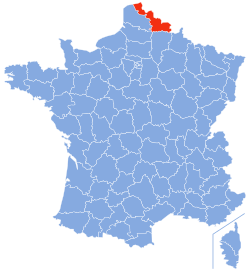Nord Department (France)
| Nord | ||
|---|---|---|
| Department | ||

Prefecture building of the Nord department, in Lille
|
||
|
||
 Location of Nord in France |
||
| Coordinates: 50°23′N 03°19′E / 50.383°N 3.317°ECoordinates: 50°23′N 03°19′E / 50.383°N 3.317°E | ||
| Country | France | |
| Region | Hauts-de-France | |
| Prefecture | Lille | |
| Subprefectures |
Avesnes- sur-Helpe Cambrai Douai Dunkirk Valenciennes |
|
| Government | ||
| • President of the General Council | Patrick Kanner | |
| Area | ||
| • Total | 5,742.74 km2 (2,217.28 sq mi) | |
| Population (1 Jan 2013) | ||
| • Total | 2,595,536 | |
| • Rank | 1st | |
| • Density | 450/km2 (1,200/sq mi) | |
| Time zone | CET (UTC+1) | |
| • Summer (DST) | CEST (UTC+2) | |
| Department number | 59 | |
| Arrondissements | 6 | |
| Cantons | 41 | |
| Communes | 648 | |
| ^1 French Land Register data, which exclude estuaries, and lakes, ponds, and glaciers larger than 1 km2 | ||
Nord (French pronunciation: [nɔʁ]; English: North; Dutch: Noorderdepartement) is a department in the far north of France. It was created from the western halves of the historical counties of Flanders and Hainaut, and the Bishopric of Cambrai. The modern coat of arms was inherited from the County of Flanders.
Nord is the country's most populous department. It also contains the metropolitan region of Lille, the fifth-largest urban area in France after Paris, Lyon, Marseille, and Toulouse. Within the department is located the part of France where the French Flemish dialect of Dutch is still spoken (along with French) as a native language.
Tribes of the Belgae, such as the Menapii and Nervii were the first peoples recorded in the area later known as Nord.
During the 4th and 5th Centuries, Roman rulers of Gallia Belgica secured the route from the major port of Bononia (Boulogne) to Colonia (Cologne), by co-opting Germanic peoples north-east of this corridor, such as the Tungri. In effect, the area known later as Nord became an isogloss (linguistic border) between the Germanic and Romance languages. Saxon colonisation of the region from the 5th to the 8th centuries likely shifted the isogloss further south so that, by the 9th century, most people immediately north of Lille spoke a dialect of Old Dutch. This has remained evident in the place names of the region. After the County of Flanders became part of France in the 9th century, the isogloss moved north and east.
...
Wikipedia

